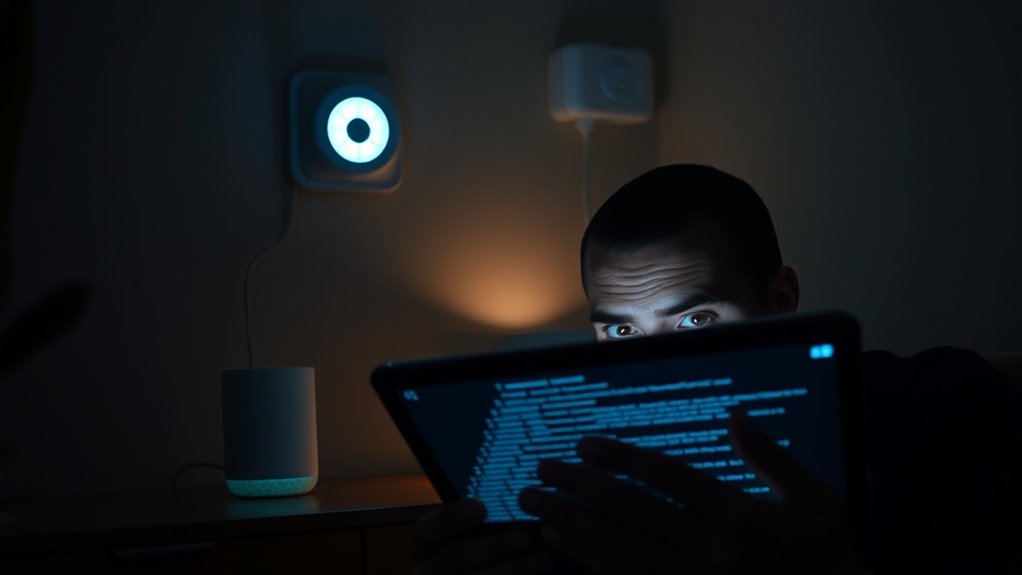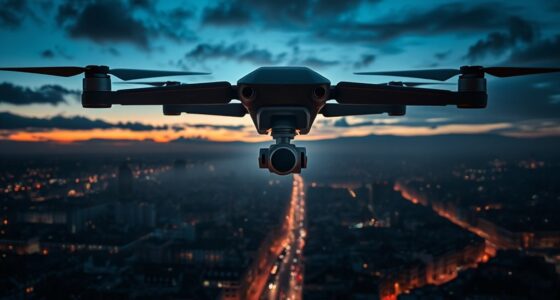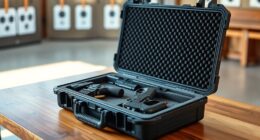Smart devices, like home assistants and cameras, can turn into espionage tools due to their vulnerabilities and constant data collection. These devices often have weak security, allowing hackers to access sensitive information. You might not even realize how much data they're gathering about your habits. This mix of convenience and potential risk raises serious privacy concerns. There are best practices and collaborative efforts to improve security that can help you protect your smart devices against these threats.
Key Takeaways
- Smart devices continuously collect personal data, often without user awareness, posing significant privacy risks and potential for espionage.
- Vulnerabilities in IoT devices allow attackers to exploit them for unauthorized data collection and lateral movement within networks.
- The CIA has demonstrated capabilities to access smart devices, highlighting the risks of espionage through compromised IoT technology.
- Weak security protocols in IoT products, combined with extensive data collection, increase the likelihood of devices being used as AI spy tools.
- Regulatory frameworks like GDPR and CCPA aim to enforce transparency and better security practices in IoT device data handling.
The Proliferation of Smart Devices in Daily Life
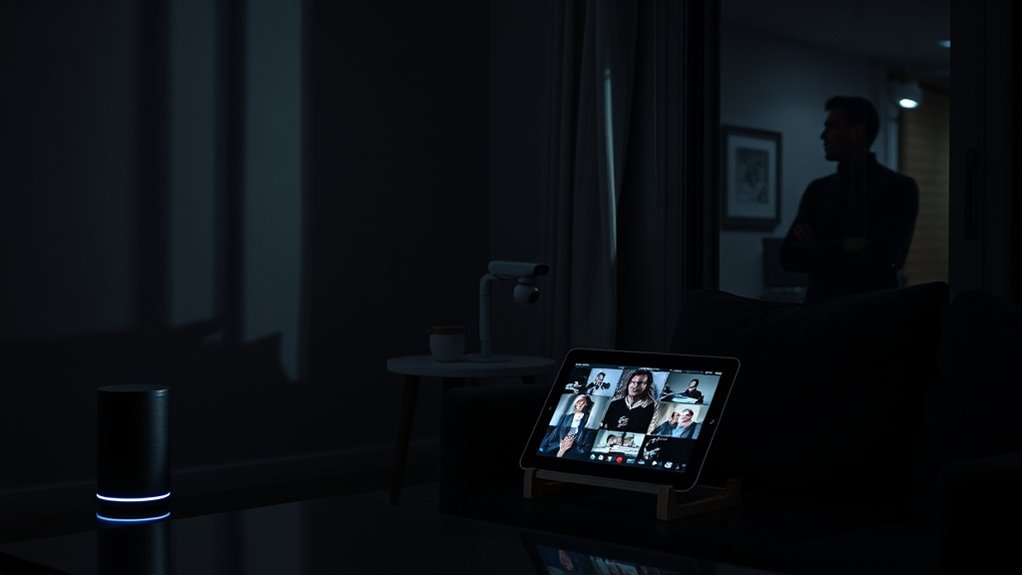
As smart devices become an integral part of your daily routine, their rapid proliferation is hard to ignore. With approximately 22 billion IoT devices in 2018, projections suggest this number could exceed 50 billion by 2030.
Smart cameras, TVs, and home assistants continuously collect extensive data about your habits, often without your full awareness. While these devices enhance convenience and efficiency across various sectors, including transport and agriculture, they also raise significant concerns about IoT security.
Many manufacturers prioritize ease of use over robust security protocols, leaving devices vulnerable to exploitation. As these devices infiltrate homes, workplaces, and cities, it's essential to understand the implications of their widespread use and the potential risks they pose to your privacy and security.
Understanding IoT Device Vulnerabilities

Here are some key security vulnerabilities to be aware of:
- Insufficient Security Protocols: Many devices are designed without robust security measures.
- Known Vulnerabilities: About 50% of devices shipped in 2020 had known security flaws.
- Network Exploitation: Attackers can exploit weak security to move laterally within networks.
- Overlooked Devices: Security teams often miss up to 20% of IoT devices, creating blind spots.
Additionally, the increasing reliance on IoT devices during events like a Microsoft outage highlights the critical need for enhanced security measures.
Understanding these vulnerabilities is essential for protecting your data and maintaining a secure environment.
The Dark Side of Data Collection

Smart devices are always watching and listening, often gathering more personal data than you realize.
While these gadgets promise convenience, they come with significant privacy trade-offs, leaving your information vulnerable to exploitation.
Understanding the risks of surveillance and data collection is essential for protecting your privacy in this interconnected world.
Surveillance by Smart Devices
In an era where convenience often trumps caution, the pervasive surveillance capabilities of connected devices raise alarming privacy concerns.
IoT devices, like smart cameras and voice assistants, frequently collect audio and video data, leading to significant risks. Here are some key points to contemplate:
- Built-in microphones and cameras on smart TVs can monitor your behavior.
- Many users remain unaware of the data collection practices by their IoT devices.
- Manufacturers often assure that data collection is limited, yet human oversight can expose vulnerabilities.
- Limited options to control data-sharing features can further compromise your privacy.
- Understanding these implications is essential as puppy socialization is crucial for healthy development in dogs, highlighting the importance of being aware of one's environment.
Your smart devices may be more than just convenient tools; they could be watching and listening in ways you didn't expect.
User Data Vulnerability
The surveillance capabilities of IoT devices extend beyond mere observation; they create significant vulnerabilities regarding user data.
While manufacturers often assure you that only automated systems access your data, human oversight can compromise this promise, as shown by Amazon's handling of Alexa information.
Many smart devices, like cameras and smart TVs, collect extensive video and audio, raising serious privacy concerns about how this data is used and shared.
You might be unaware of the extent of data collection and storage practices, leading to potential user data vulnerability.
Although regulations like GDPR and CCPA aim to protect your privacy, it's essential to stay proactive.
Regularly updating firmware and disabling unnecessary data collection can help mitigate these risks. Furthermore, continuous monitoring of AI behavior is crucial to ensure that these devices do not inadvertently compromise user privacy.
Privacy Trade-offs Explained
While you may enjoy the convenience of smart devices, it's crucial to understand the privacy trade-offs that come with their use. Here's what you should consider:
- Data Collection: Devices often capture extensive audio and video data, raising monitoring concerns.
- Awareness: Most users remain unaware of how much data is collected, from sleep patterns to object recognition.
- Human Oversight: Manufacturers may claim that only automated systems access data, but human review can happen, as seen with Amazon's Alexa.
- Security Risks: Weak security in many IoT products can leave your data vulnerable to hacking, jeopardizing your privacy.
Being informed about these trade-offs can help you make smarter choices about the devices you use and the data you share.
Real-World Examples of IoT Espionage

As smart devices become increasingly integrated into our daily lives, their potential for espionage raises significant concerns.
In 2017, WikiLeaks exposed nearly 9,000 pages of CIA documents revealing that the agency could exploit vulnerabilities in IoT devices, like smartphones and smart TVs, for surveillance. These leaks showed that the CIA could access both Android and Apple smartphones, as well as Internet-enabled vehicles, creating serious privacy issues.
Security experts warned that criminals could also use these vulnerabilities for unauthorized data collection, endangering public safety.
In response, major tech companies, including Apple, Google, and Samsung, have ramped up efforts to patch these security flaws. The CIA's ability to bypass encryption in secure apps like Signal further highlights the risks of IoT devices.
Privacy Concerns in the Age of Surveillance

As you use smart devices, it's vital to take into account how much data they're collecting about you.
Many people aren't fully aware of their rights under privacy regulations like GDPR and CCPA, which can leave them vulnerable.
Understanding the gaps in user awareness and the implications of data collection practices is essential for protecting your privacy in today's surveillance-driven world.
Data Collection Practices
Smart devices have become ubiquitous in our lives, collecting vast amounts of data that often go unnoticed.
These data collection practices raise significant privacy concerns, including:
- Surveillance: Devices like cameras and smart assistants record audio and video, often without your full awareness.
- Data Mismanagement: Many users underestimate how much data is collected and stored by these devices.
- Human Oversight: While manufacturers claim automated systems handle your data, human oversight can occur, as shown by incidents with companies like Amazon.
- Regulatory Gaps: Regulations like GDPR and CCPA aim to protect your privacy, but you must take the initiative to submit Data Subject Access Requests (DSAR) to truly understand how your data is being used. Additionally, the growing public awareness of AI's implications on personal data is driving demand for stricter privacy regulations.
User Awareness Gaps
Many people underestimate how much their smart devices invade their privacy, leaving them vulnerable to surveillance and data misuse. User awareness gaps contribute greatly to this issue. Many users don't realize how much data their devices collect or how it's used.
| Device Type | Data Collected | User Awareness |
|---|---|---|
| Smart Speakers | Audio recordings | Low |
| Smart Cameras | Video footage | Very low |
| Fitness Trackers | Health and location data | Moderate |
Without robust security measures, your data's at risk. While regulations like GDPR and CCPA exist, many remain unaware of their rights. You must weigh convenience against privacy and understand the risks before using these devices. Additionally, many users fail to consider how AI technologies can improve threat detection in cybersecurity, leaving them more exposed to potential breaches.
Regulatory Frameworks Impact
While the rise of smart devices offers convenience, it also brings significant privacy concerns, especially in the context of regulatory frameworks like the GDPR and CCPA.
You should be aware of how these frameworks can impact your privacy:
- Data Protection: They enforce stricter guidelines on how your data can be collected and used.
- User Rights: You gain more control over your personal data, including the right to access and delete it.
- Accountability: Manufacturers must be transparent about data handling, reducing the risk of unauthorized access.
- Security Standards: Enhanced regulations push for better security measures, addressing vulnerabilities in IoT devices. Furthermore, these frameworks can strengthen essential oil safety by ensuring that consumer data related to health and wellness is adequately protected.
Ultimately, these regulatory frameworks are essential in safeguarding your privacy in an increasingly interconnected world.
The Role of AI in Enhancing Security Risks
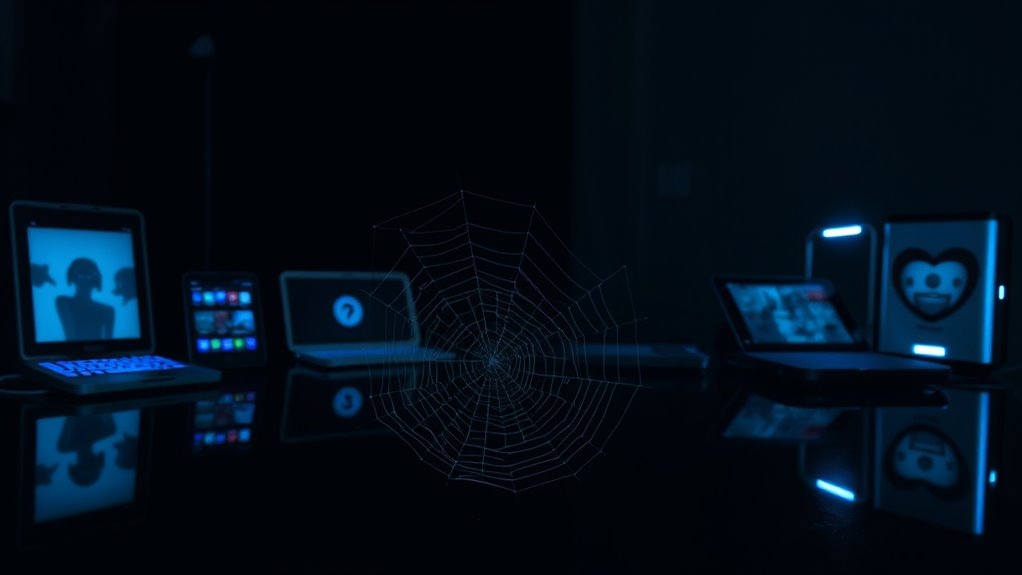
As AI technology advances, it not only boosts the functionality of smart devices but also introduces new security vulnerabilities that hackers can exploit.
Smart devices, like cameras and voice assistants, collect extensive personal data, and if security measures are lacking, that data can be intercepted or misused. Research shows that many IoT devices lack robust security features, with half of those shipped in 2020 containing known vulnerabilities.
Smart devices gather vast personal data, and inadequate security can lead to interception and misuse, highlighting the need for stronger protections.
AI's ability to analyze vast amounts of data can uncover patterns that expose sensitive information, making these devices prime targets for cyberattacks.
As AI evolves, adopting proactive security measures, like post-quantum cryptography and a security-by-design approach, becomes essential to mitigate the risks associated with IoT espionage.
Best Practices for Protecting Your Smart Devices

To keep your smart devices secure, regularly update their firmware to patch vulnerabilities.
You should also disable any unnecessary data collection features, as this limits the risk of unauthorized access to your personal information.
Regular Firmware Updates
Regular firmware updates are essential for keeping your smart devices secure, especially since many shipped in 2020 contained vulnerabilities that hackers could exploit.
To protect your devices, follow these best practices for firmware updates:
- Check Regularly: Actively monitor for updates, as many devices lack automatic update features.
- Follow Manufacturer Guidelines: Refer to the instructions provided by manufacturers for ideal update procedures.
- Prioritize Security: Choose devices from companies that prioritize timely firmware updates, showcasing their commitment to security.
- Don't Delay: Apply updates promptly to avoid exposing your devices to known threats that attackers could exploit.
Additionally, automation of security protocols through regular updates can significantly reduce potential vulnerabilities in your smart devices.
Limit Data Collection
Keeping your smart devices secure goes beyond just firmware updates; it also involves being mindful of the data they collect. Start by disabling unnecessary data collection features on your devices, as manufacturers often prioritize convenience over privacy.
Research manufacturers' data practices before purchasing, opting for those with transparent privacy policies. You'll want to utilize settings to limit the sharing of personal data with connected services, as many smart devices, like cameras and assistants, may collect more than you realize.
Consider choosing devices that offer strong privacy controls, allowing you to disconnect from the internet or manage data sharing preferences. By taking these steps, you can better protect your privacy and reduce the risks associated with IoT espionage. Additionally, be aware of cookie management options to gain greater control over data collection on your devices.
Collaborative Efforts to Improve IoT Security

As the number of IoT devices continues to surge, effective collaboration among manufacturers, consumers, and regulators becomes increasingly essential to enhance security.
Here's how you can contribute to these efforts:
- Adopt Standards: Support initiatives like NIST's post-quantum cryptography standards to guarantee your devices are secure against emerging threats.
- Implement Policies: Organizations need to recognize their role by adopting thorough security measures that protect both users and devices.
- Monitor Continuously: Regularly assess and adapt your security practices to counteract vulnerabilities in the growing IoT landscape.
- Promote Collective Responsibility: Collaborate with stakeholders to increase pressure on manufacturers, ensuring they prioritize security during the development of new devices.
Together, these actions can greatly bolster IoT security and reduce risks.
The Importance of Security-by-Design in Device Development
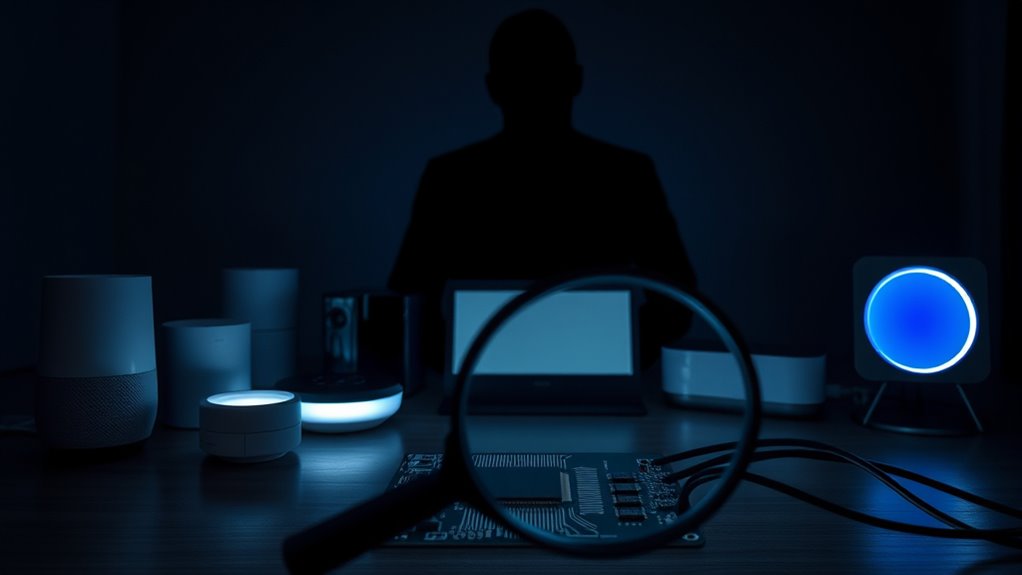
While many manufacturers focus primarily on functionality and aesthetics, prioritizing security-by-design is essential in developing IoT devices. This approach integrates security from the start, preventing vulnerabilities that could lead to data breaches. Without certified chips and robust software, even one weak entry point can compromise your entire system.
| Lifecycle Stage | Importance of Security-by-Design |
|---|---|
| Design | Security features must be embedded |
| Manufacturing | Use certified components |
| Deployment | Secure configurations are vital |
| Maintenance | Regular updates to patch vulnerabilities |
Robust security measures tackle poor design and weak controls linked to data leaks. Investment in security is critical for manufacturers to ensure long-term consumer trust. Regulatory bodies must enforce security-by-design principles to protect consumer IoT products effectively.
Future Trends: Preparing for the Next Wave of Threats
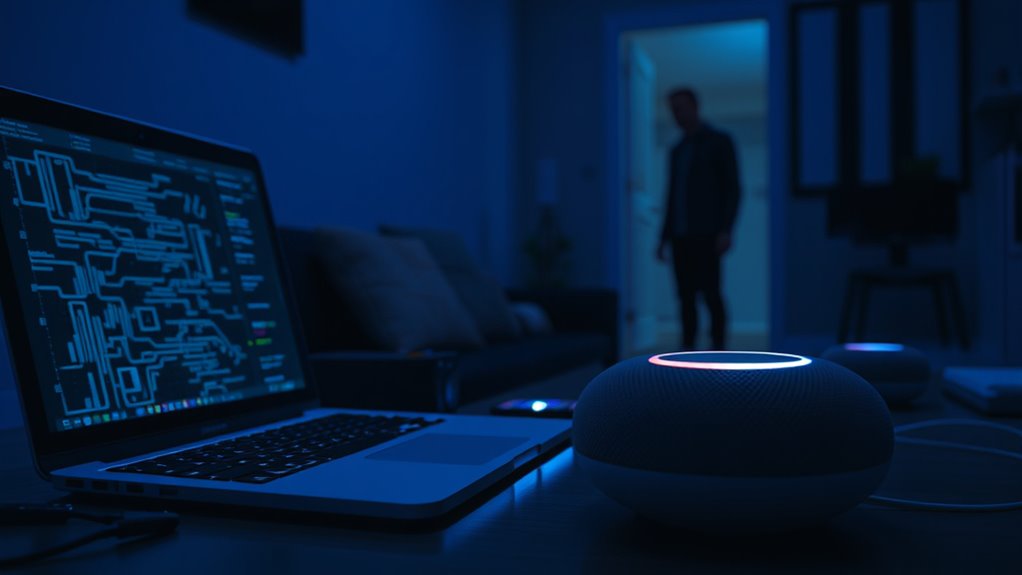
With the rapid expansion of IoT devices, security challenges are evolving at an alarming rate.
By 2030, we could see over 50 billion IoT devices, increasing the risk of espionage.
To prepare for the next wave of threats, consider these trends:
- Post-quantum cryptography will become essential to safeguard against emerging quantum computing capabilities.
- Expect regulatory frameworks, like those from NIST, to shape security standards across the IoT landscape.
- Collaboration between manufacturers, consumers, and regulators will be significant in ensuring devices prioritize security from the start.
- Awareness of known vulnerabilities will help you mitigate risks proactively.
Staying informed and adaptable is critical as IoT continues to evolve and present new challenges.
Frequently Asked Questions
How Is AI Influenced by Iot?
AI's influenced by IoT in several powerful ways. When you use smart devices, they gather data that AI processes for insights and improved functionality.
This data helps AI learn patterns and make decisions, like adjusting your thermostat or optimizing routes for deliveries. As IoT devices proliferate, the data they provide becomes richer, enabling AI to enhance user experiences and automate tasks.
However, always be aware of how your data's being handled.
Can Smart Devices Spy on You?
Imagine your home filled with silent watchers, ready to capture every moment. Yes, smart devices can indeed spy on you.
They often come equipped with cameras and microphones, collecting audio and video data without you realizing it. While manufacturers assure you that only automated systems access your data, there have been cases where human oversight occurs.
Plus, hackers can exploit vulnerabilities, turning these seemingly innocent gadgets into tools for unauthorized surveillance.
Stay vigilant!
What Is the Synergy Between AI and Iot?
The synergy between AI and IoT creates a powerful combination for enhancing device functionality and user experience.
You'll find AI algorithms analyzing data from millions of connected devices in real-time, which helps automate processes and make smarter decisions.
This collaboration allows your smart home to learn your preferences, adjusting settings like temperature automatically.
As a result, your everyday life becomes more efficient, tailored, and connected, ultimately transforming how you interact with technology.
What Are the 4 Types of Iot?
You know what they say: "Good things come in fours."
When it comes to IoT, there are four primary types to contemplate.
First, there's consumer IoT, which includes smart home devices.
Then, you've got industrial IoT, enhancing manufacturing and logistics.
Commercial IoT focuses on retail and healthcare efficiency, while infrastructure IoT optimizes city services.
Each type plays a vital role in shaping our connected world, making life easier, and improving efficiency.
Conclusion
As smart devices become integral to our lives, it's essential to stay vigilant about their security. You might think, "I don't have anything to hide," but even everyday data can be exploited. By following best practices and advocating for better security measures, you can protect your privacy and enjoy the convenience of IoT without fear. Embracing security-by-design not only safeguards your information but also helps create a safer digital environment for everyone. Stay informed and proactive!
